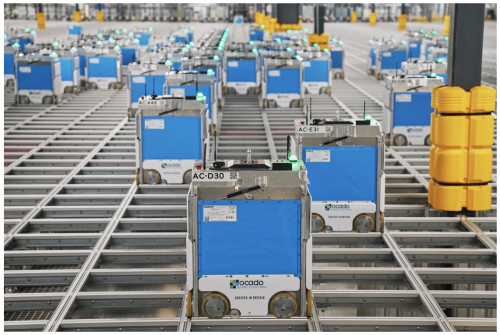I have long been fascinated by supermarket retailing. It’s one of those categories that is truly evergreen, because we will always need food. Since we can’t dine out 21 times a week, we’ll be buying groceries as long as humans inhabit this planet.
And as long as our population continues to increase, either by births, increased lifespan, or immigration, it’s a perpetual growth market. We’ll need more supermarkets in 10 years than we need now. Maybe. More on that in a sec.
See How They Grow
Normally, the ways that chain grocers expand is by either building more stores in existing or new markets, or by acquiring regional chains that will give it an instant footprint in a new market. These are strategies that have been used by all of the big regional chains. Examples include Florida’s Publix as it expands north from Alabama to Virginia, and Kroger, which owns chains across the country.
But now Kroger has thrown down the gauntlet and is going to take on Publix in Florida with its new robot-powered warehouse. They have no plans to open any stores there at all.

This is Kroger’s game plan going forward as it will build 20 of these warehouses, also called CFCs (Customer Fulfillment Centers), or more colloquially, sheds. They are the result of a partnership with the British firm Ocado. Their first one opened in Ohio just north of Cincinnati. The rest will be up and down the Middle Atlantic states and throughout Florida. The one that just opened in Groveland is their first in the state.
Eye (I) Robot
What sets these sheds apart from stores and other traditional warehouses is that they will be staffed primarily by robots. Humans will drive the fleet of delivery trucks, which look like massive Kroger billboards on wheels. The Groveland shed cost about $55 million to build. Even though Kroger hired 900 employees, there are far fewer than what there would be with actual stores.
And no robots.
All of this signals Kroger’s wager that robots and e-commerce are the future of supermarkets and grocery retailing. It’s a gutsy move at minimum. Kroger is betting that COVID finally cinched the deal for online grocery shopping, and that we would really rather spend our time doing other things.
Formidable Competition
Taking on Publix is also going to be tough, because they are firmly entrenched in the Florida grocery retailing market. While their prices tend to be far higher than at Walmart or a Super Target, they have a very loyal following. My stepson is an assistant department manager at an Orlando area store.
I have heard many tales from him about Publix shoppers, who come for the quality meats, fresh produce, and overall selection. In fact, Publix shoppers tend to love the experience of just being there. The chain has also been very slow and admittedly reluctant to install self-check lanes, because it wants to provide the human touch.
Which makes me wonder if Kroger will be stealing supermarket shoppers from Publix at all, and maybe Winn Dixie instead, which is a distant competitor. I doubt they will steal from Walmart or Super Target, which both also have delivery teams waiting to hop in a van. Aldi and Trader Joe’s shoppers are loyal for different reasons (and with no delivery either). Finally, Whole Foods, which is owned by Amazon, is a little different. It has high customer loyalty and its delivery fleet ready to serve, but their new $9.95 fee may deter some.
Join The Club
And that brings up another item in the news recently: Kroger’s new two-tiered membership program. Kroger Boost will offer same-day or two-day delivery, based on membership level, along with 2X fuel points. It is only available right now in Indianapolis, Columbus OH, Cincinnati, and Atlanta, but will roll out elsewhere soon. It’s too early to know how this will all work with the robot-powered warehouses; one thing is certain, though: customers won’t be able to buy fuel there.
I also have some reservations about the Groveland location. I’m pretty sure they went there because land is cheaper in the middle of the state, especially near the Green Swamp. It’s 30 miles west of Orlando, which has more than two million people in its metro area. But trying to drive from Groveland to the east side of Orlando will probably take two hours on Highway 50, thanks to relentless traffic. As for Tampa, it is located even farther away to the southwest.
In other words, they may be centrally located, but conveniently close to nothing other than the bedroom community of Clermont. I hope they factored in the price of fuel for all those trucks.
Share And Share Alike
Still, this is a bold move, and if it plays out, you can expect others to follow suit. Publix may be able to sit on its laurels for now, but will be watching carefully. The chain has more than a 45% share in most Florida trade areas. But since the state’s population is growing at just under 2% per year, more grocery shopping options will be needed each year for the foreseeable future. Kroger hopes to bank on that whether it puts the squeeze on Publix or not. It’s a lot easier to grab market share when the market itself is expanding.
My fascination level just doubled with this move. I can only wish this were the state of the industry when I did my dissertation on supermarketing more than 30 years ago. But then again, maybe one of my students would like to carry this torch. There’s a dissertation just waiting to be written.
Put that on your plate and think about it.
Dr “Eye Robot“ Gerlich


